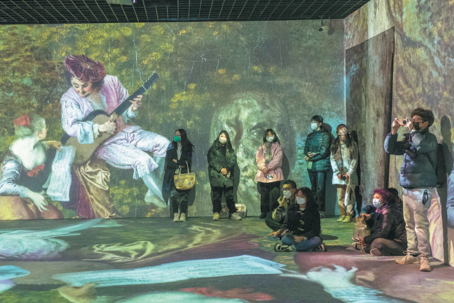Museums are popular but ease of entry is history
Planning early is essential as tickets may be sold out, Deng Zhangyu reports.

During the weeklong Spring Festival holiday in late January, Li Jingjing visited four museums in three days with her parents in Beijing. A delightful and educational endeavor. But there were problems. The expected ease of getting admission tickets to certain venues seemed to have become a thing of the past. Tickets to popular museums in Beijing were all snapped up before the holiday.
Li went to China National Arts and Crafts Museum on Jan 24, the third day of the Spring Festival holiday, traditionally a date when people usually go to visit family members. The 34-year-old thought that it would not be that busy, as it only opened to the public last year. However, its holiday tickets were sold out.
She kept refreshing the ticket sales app, finally succeeding in obtaining three that had been returned by someone who couldn't go.
"I felt so lucky when I got the tickets. I never thought that museum admission would be so hard to obtain," says Li, who works at an investment company in Beijing and loves visiting museums at home and abroad.
However, it was her first time visiting museums during Spring Festival. Previously, she would take trips with her family or visit other relatives, a similar routine to many Chinese people during what is widely considered to be the most important holiday of the year.
When Li and her parents arrived at the China National Arts and Crafts Museum at about 10 am, they queued for about half an hour to get in. The six-floor museum, with its seven big exhibition halls, was full of visitors. It was hard to find a seat to take a break during their daylong visit.
"We loved the exhibitions of paper-cutting and shadow puppets. It was so interesting and fascinating that we stayed until the last minute," says Li, adding that it was worthwhile, despite the crowds.
She notes that most visitors were parents with children or infants.
Over the next two days, Li visited the China National Film Museum, China Aviation Museum, and the Military Museum of the Chinese People's Revolution. She says that the key reason for her choice of venues was the availability of tickets.
Li's original plan was to go to the Palace Museum and the National Museum of China, but both were sold out before the holiday even began.
According to Beijing Cultural Heritage Bureau, more than 1 million people visited museums in Beijing during the weeklong holiday. The hottest ticket is the Palace Museum, also known as the Forbidden City. It welcomed 230,000 visitors during the holiday. Close behind was the National Museum of China, which hosted 90,000 visitors.
It wasn't only museums in Beijing that witnessed a holiday boom. All across China, cultural venues enjoyed an uptick in footfall, as crowds poured into museums and galleries to find historical and artistic enlightenment.
Before the holiday, the National Cultural Heritage Administration had encouraged museums to present Spring Festival-related shows and activities to attract people to celebrate the Year of the Rabbit at museums.
The administration says that about 2,200 exhibitions and activities were planned by 900 museums across China, such as the display of images or relics pertaining to the Chinese Zodiac, especially those related to the rabbit. Another popular draw was the opportunity to participate in Chinese calligraphy, particularly writing the character fu (good fortune), while sending uniquely designed red envelopes with patterns from museum collections to visitors also proved popular. Many museums even extended their opening hours to 8 pm to accommodate more visitors.
Known for its exotic-looking bronze statues and gold masks, Sanxingdui Museum in Guanghan, Sichuan province, held a prayer ceremony for auspiciousness during the holiday. It attracted so many tourists that it hit headlines and topped the list of hot topics on micro-blogging platform Sina Weibo.
According to the museum, it received 115,600 visitors during the holiday week. To avoid jams and guarantee the safety of the relics, the museum introduced new regulations and policies, and had more staff members on duty during the vacation.
In Shanghai, people lined up outside museums to see shows displaying Western masterpieces. A queue formed at 6 am outside the Shanghai Museum for its show Botticelli to Van Gogh: Masterpieces From the National Gallery, London, which features 52 oil paintings by masters collected by London's National Gallery. Shanghai Museum says that in five days, about 34,000 people came through the doors, up 82 percent compared to last year.
Zhang Haijun, deputy director of Changsha Museum in Hunan province, says that museums have provided excellent exhibits, interesting and fun activities for people to explore, as well as employing the latest technology to make presentations more sophisticated and memorable.
"Museums no longer just present exhibitions. We offer a good cultural experience," Zhang says.
The five-story Changsha Museum received more than 30,000 visitors from Jan 24 to 27, the highest it has been in three years.
Zhang says that one third of their visitors were people under 18. They curated a series of interactive activities and invited children to take part in arts and crafts, such as teaching them Spring Festival woodblock printing and showing them how to repair relics.
Wang Jingzhi went to the Changsha Museum with her 7-year-old daughter on Jan 25. They were attracted by a folk art show and an exhibition focusing on Zodiac animal-related relics.
Her daughter spent several hours collecting the stamps of seals provided at the various halls in her notebook. "It was our first time visiting the museum at Spring Festival," says Wang. "I didn't know that there were so many interesting activities at museums. It's much more attractive than going to a shopping mall."
The mother says that she did some research online to find a suitable place to go with her child during the Spring Festival holiday and was finally attracted by a recommendation for the museum on Xiaohongshu, a popular lifestyle social media platform.
"Many museums use social media to promote their shows. It's a good way to reach a wider audience. If I didn't see the promotion, I wouldn't have come," says Wang.
Changsha Museum has been active on many social media platforms, such as Sina Weibo, video-sharing platform Douyin and instant messaging app WeChat. After visiting Changsha Museum, the mother says that they planned to go to Hunan Museum, a provincial-level museum with many high-profile relics. However, tickets were snapped up before the holiday. The daily cap on visitors to the museum is 12,000. "Besides shopping and having meals at fancy restaurants, visiting museums will be added into our Spring Festival to-do list in the future," Wang says, adding that visiting museums is meaningful for her daughter.
Ji Fangfang, associate professor with the Chinese Academy of Social Sciences, says that the popularity of museums during the Spring Festival holiday is a reflection of the popularity of Chinese traditional culture. Another reason is people's growing desire for spiritual enjoyment.
"In the past few years, Chinese traditional culture has been promoted at all levels and is therefore favored by the younger generations. Museums are the top choice for people to learn about Chinese culture," Ji says. "Young people also love to share their visit on social media.
"The employment of social platforms by museums, and people's sharing of their experiences online, also help to fuel the boom," Ji adds.
Zhu Youfang in Changsha contributed to this story.



Today's Top News
- Restoring truth is the least we can do to serve history
- Israeli airstrikes hit Gaza amid worsening humanitarian crisis
- Book on Confucianism launched in Brussels
- Right track for China-ROK ties lauded
- Nursery rooms help fathers take part in parenting duties with more ease
- Typhoon Kajiki brings heavy rain in Hainan































